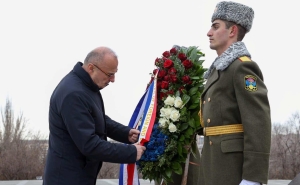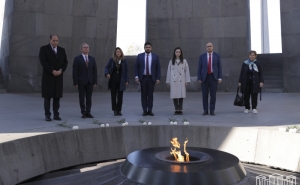Japanese Helped Save Armenians and Greeks from Being Drowned and Being Burnt During Genocide

As Asbarez.com reports, perhaps the most remarkable story of Japanese humanitarianism during the Armenian Genocide was the role played by the captain and crew of a Japanese ship in saving lives during the 1922 Smyrna Catastrophe. Hundreds of thousands of Armenian and Greek refugees had fled to the quay of Smyrna as Turkish nationalist troops entered and occupied the city on 9 September 1922. The Turkish occupation was followed by the usual massacre and deportation of Armenian & Greek civilians. A fire broke out in the Armenian quarter four days later which destroyed much of the city. Having full view of the catastrophe were some 20 allied warships and freighters stationed in the harbor including one from Japan. Many foreigners witnessed the Japanese ship mobilize to rescue the frantic refugees. Mrs. Anna Harlowe Birge, the wife of the American Professor Birge of the International College at Smyrna, witnessed the desperate refugees crowding each other off the wharves as Smyrna began to burn. Men and women could be seen swimming around in the hope of rescue until they drowned. Anna wrote:
"In the harbor at that time was a Japanese freighter which had just arrived loaded to the decks with a very valuable cargo of silks, laces and china representing many thousands of dollars. The Japanese captain, when he realized the situation did not hesitate. The whole cargo went overboard into the dirty waters of the harbor, and the freighter was loaded with several hundred refugees, who were taken to Piraeus and landed in safety on Greek shores," wrote Stavros T. Stavridis in an article published in the American Helenic International Foundation’s Policy Journal.
Another account was published on 18 September 1922 by the New York Times:
"Refugees constantly arriving .. relate new details of the Smyrna tragedy. On Thursday [September 14] last there were six steamers at Smyrna to transport the refugees, one American, one Japanese, two French and two Italian. The American and Japanese steamers accepted all comers without examining their papers, while the others took only foreign subjects with passports."
The humanitarian actions of the Japanese ship have also been recorded by Armenian and Greek survivors of Smyrna. They are some of the many testimonies and eyewitness accounts that historians Stavros Stavridis and Nanako Murata-Sawayanagi of Japan have uncovered in their research on Japan and the Smyrna Catastrophe. Recently, Stavridis discovered the ship’s name – the Tokei Maru – which had been published in numerous contemporary Greek newspapers. In June 2016, Greek community organisations in Athens, Greece, awarded a shield shaped plaque to Japan’s ambassador, Masuo Nishibayashi, in honour of his nation’s rescue efforts at Smyrna in 1922. It’s a gesture that I believe Armenian communities should follow.
Japan’s humanitarian response is only one of the many stories of international goodness during the catastrophic events that almost entirely destroyed the Ottoman Empire’s native Christian communities. More than 50 nations participated in the global humanitarian relief effort to save survivors of the Armenian Genocide. While much of the scholarship on the genocide has focused on the evils committed, there are countless stories of human compassion and generosity that still need to be explored by scholars.
-
 17:08
17:08The regular session of the Anti-corruption Policy Council takes place in Jermuk
-
 15:05
15:05The Prime Minister sends congratulatory messages to the supreme leader of Iran and the President of Iran
-
 11:11
11:11Armenia sends earthquake aid to Turkey
-
 10:43
10:43Commemoration of the Pontiff St. Sahak Partev
-
 09:16
09:16Some roads are closed and difficult to pass in Armenia
-
 19:55
19:55Phone conversation of the Foreign Minister of Armenia with the U.S. Assistant Secretary of State for European and Eurasian Affairs
-
 18:30
18:30Prime Minister Pashinyan and President Khachaturyan meet
-
 18:20
18:20Ararat Mirzoyan with Co-Chairman of the OSCE Minsk Group of France Brice Roquefeuil
-
 17:01
17:01Humans could land on Mars within 10 years, Musk predicts
-
 16:45
16:45France, US urge 'immediate' end to Nagorno Karabakh blockade
-
 16:01
16:01Blockaded Nagorno Karabakh launches fundraiser to support quake-hit Syria
-
 15:59
15:59Earthquake death toll in Turkey rises to 18,342
-
 15:43
15:43Ararat Mirzoyan Held a Telephone Conversation with Sergey Lavrov
-
 15:06
15:06French president rules out fighter jet supplies to Ukraine in near future
-
 14:47
14:475 Day Weather Forecast in Armenia
-
 14:44
14:44President Vahagn Khachaturyan wrote a note in the book of condolences opened in the Embassy of Syria in Armenia
-
 14:20
14:20Azerbaijan’s provocations impede establishment of peace and stability – Armenian FM tells Russian Co-Chair of OSCE MG
-
 12:57
12:57France representation to OSCE: Paris calls on Azerbaijan to restore freedom of movement through Lachin corridor
-
 11:40
11:40Command of Kosovo forces highly appreciated preparation of Armenian peacekeepers
-
 10:16
10:16The United States withdrew from sanctions against Syria for six months the provision of assistance after the earthquake
day
week
month
Humidity: 17%
Wind: 1.03 km/h









